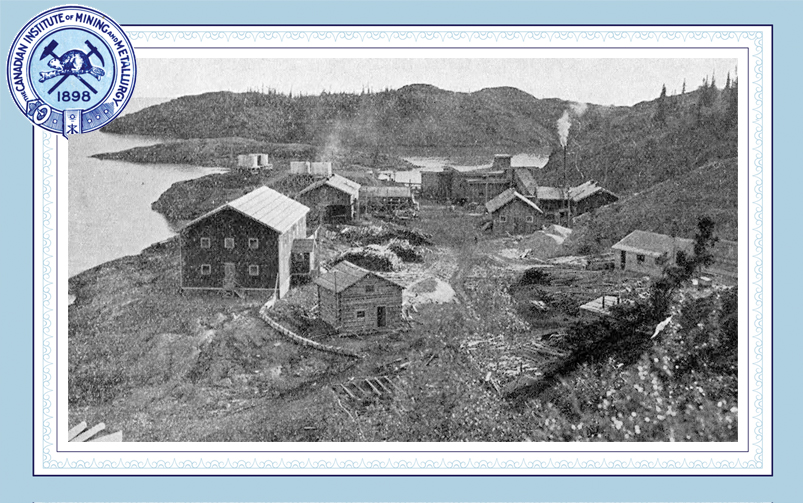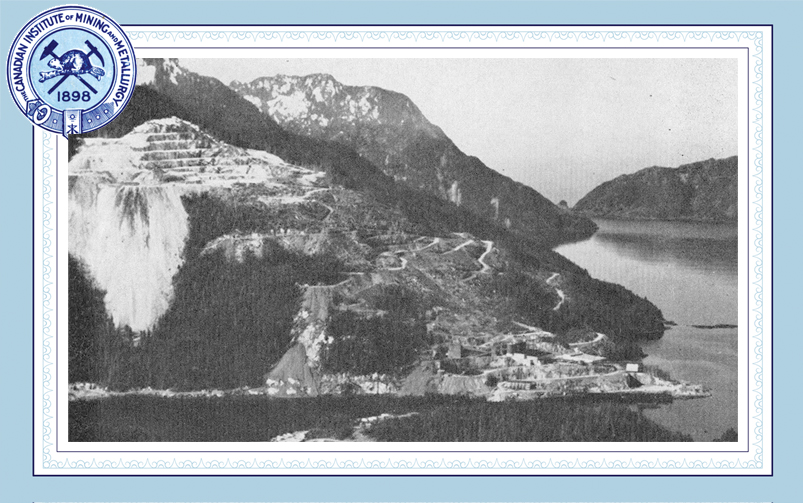Eldorado’s Beaverlodge camp in 1952 (CIM Bulletin, May 1953).
The Beaverlodge area of northern Saskatchewan has a significant history of uranium discovery and development. While initial interest in the region was for gold, the presence of radioactive minerals was noted early on.
“In the summer of 1934, gold was discovered on Lodge Bay, on the north shore of Lake Athabasca in northern Saskatchewan, about fifty miles east of the Alberta boundary line,” wrote F.J. Alcock (CIM Bulletin, 1936). “The first claims were taken up by the Consolidated Mining and Smelting Company of Canada [Cominco], and there was a ‘rush’ to locate similar showings.”
In summer 1935, this area was named Goldfields, Alcock wrote, reflecting the expectation that this area of Saskatchewan would become a new gold mining hub.
“Occurrences of galena and sphalerite are known in the region, and during the past summer a discovery of pitchblende was made two miles east of Goldfields,” he wrote. “Though these showings are of interest, they are apparently too small to be developed economically. The future of the region, from the mineral point of view, appears to rest with the gold deposits.”
A.M. Christie and S.N. Kesten (CIM Bulletin, December 1949) recorded that this initial radioactive mineral discovery was at Cominco’s Nicholson property.
Cominco’s Box gold mine opened in Goldfields in June 1939 but closed less than three years later. “Mining came to an end in [May] 1942 as a result of the low grade of the ore and the changed economy of the war years,” wrote S.C. Robinson (CIM Bulletin, April 1952).
However, according to Christie and Kesten (1949), one minor occurrence of the uranium mineral, thucholite, was reported from the Box mine during its period of operation.
The Beaverlodge area received renewed attention in the 1940s due to an increase in uranium demand during the Second World War. “In September 1943, all discoveries of radioactive minerals were reserved to the Crown and their staking by private interests was banned,” wrote David S. Robertson (Uranium Deposits of Canada, CIM Special Volume 33, 1986).
In January 1944, the Canadian government nationalized Eldorado Gold Mines—which had reopened its Port Radium mine in the Northwest Territories in 1942 to supply uranium for the Manhattan Project (see the August 2025 issue)—as a Crown company. In 1945, it began an intensive prospecting programme in the Beaverlodge area.
After the end of the war, both the United States and the United Kingdom still required large amounts of uranium. In 1948, the federal government repealed the ban on public prospecting for uranium. “Shortly thereafter, the Government of Saskatchewan established the concession system of leasing prospecting rights,” wrote Robinson (1952).
On Aug. 4, 1952, the ground not retained by the concession holders came open for general staking, wrote A.H. Lang (CIM Bulletin, May 1953). “About 250 persons took part in a staking ‘rush,’ some were amateurs, some were experienced prospectors, and some were representatives of companies, previously active in the region, that wished to enlarge their holdings,” he wrote. “About 1,000 claims were staked, bringing the total number of claims in the region to about 3,000, in about 175 groups.”
Development of Beaverlodge
According to Lang (CIM Bulletin, August 1950), the Goldfields or Beaverlodge region contained the most important uranium deposits found in Canada since the Eldorado mine at Port Radium. “Extensive development work was done on several of the discoveries in 1948 and 1949, substantial camps were built at the Nicholson and Eldorado properties, and roads were built to connect the principal operations with the barge route from Waterways,” he wrote.
In 1949, Eldorado sank two prospect shafts at its Ace and Eagle properties, and decided to initially concentrate resources on developing the Ace property; it was later developed into the larger Beaverlodge operation that also incorporated Eldorado’s nearby Fay and Verna properties.
“The work at the Ace [property] was particularly encouraging,” wrote Lang (1953). “The company announced in 1951 that it was possible to forecast an operation with a minimum of 500 tons a day, with good prospects of a larger tonnage.”
Lang (1953) mentioned that about 800 men were employed in constructing the Ace mine in preparation for production in early 1953, and that three new communities were growing in the district. “The Eldorado company has nearly completed a large camp at Beaverlodge Lake, including modern homes for its staff, a school and a hospital,” he wrote. “A smaller settlement at the beginning of the road has been named Bushell. About midway between Beaverlodge and Bushell the Saskatchewan authorities have laid out a large townsite, called Uranium City.”
Carbonate leaching
Unlike ore from Port Radium, ore from the Beaverlodge operation had a high calcite content, making it unsuitable for acid leaching processes. John Convey and L.E. Djingheuzian (CIM Bulletin, April 1965) quoted P. L. Stevenson’s description of the Mines Branch’s research in Ottawa: “A sulfuric acid leach was introduced at Port Radium, but at Beaverlodge a high-pressure, high-temperature carbonate leach was initiated.”
A.D. Turnbull (CIM Bulletin, April 1963) described the development of the acid leach process and the carbonate leach process for recovering uranium as one of the important developments on the Canadian scene in recent years. “The application of these processes on a large scale meant research on many problems of corrosion and abrasion as well as on the basic chemistry of the processes,” he wrote. “At Beaverlodge, for example, a serious corrosion problem was overcome by a method of alkalinity control, which was developed in laboratory studies.”
J.A.H. Paterson (CIM Bulletin, July 1953) mentioned that in early 1953, “after the expenditure of probably more than $15 million, the first 500-ton unit of a 2,000-ton capacity production plant will begin operation at Beaverlodge.”
Mill production began in April 1953 using stockpiled underground development ore, according to E.E.N. Smith (SV 33, 1986). “Initial underground production came from the Ace-Fay footwall orebodies to which was added Verna hanging wall ore beginning in 1957,” he wrote.
H.E. Lake and J. Russell (CIM Bulletin, October 1956) recorded that the mill was due to increase capacity from 700 tons to 2,000 tons per day and that “the present plant will be considerably altered within the ensuing year to handle the increased tonnage and distribution.”
The Beaverlodge operation implemented the adoption of mill tailings for underground backfill, starting in 1954. “Mining and milling commenced in June 1953, using locally available sand as backfill, while testwork and installation of a plant was carried out to prepare and deliver the tailings to the mining areas,” wrote Lake and Russell (1956). “The first use of tailings was made in February 1954, a sand slime separation being carried out with hydraulic cyclones.”
End of the uranium boom
“At the end of 1959, the [uranium] boom ended when the U.S. Atomic Energy Commission, our biggest customer, announced it would not take up its option on further supplies of Canadian uranium,” wrote M.C. Campbell, G.M. Ritcey and W.A. Gow (CIM Bulletin, March 1985).
This resulted in the closure of all of the small producers in the Beaverlodge area, leaving only Eldorado’s Beaverlodge operation and Gunnar Mines’ Gunnar operation open. “The Gunnar orebody was depleted in 1963, and at present Eldorado Nuclear is the sole producer,” wrote J.S. Beck (CIM Bulletin, March 1970).
Uranium demand dropped again in the early 1980s. “Cutbacks in nuclear power development plans, due somewhat to energy conservation programs, led to reduced demand for uranium and rapidly dropping export prices,” wrote Campbell et al (1985). “This resulted in mine closures and a general malaise.”
The closure of the Beaverlodge operation was announced in 1981, due to “declining ore grade and mill recoveries, and increasing production costs,” wrote R.L.J. Phillips, K.T. Himbeault, B.J. Topp, B.E. Halbert and S.L. Fernandes (CIM Bulletin, November/December 2000). “The mill ceased production in August 1982, and decommissioning was completed in 1985.”
Between 1953 and 1982, the Beaverlodge mill had recovered 21,457,947 kilograms of U3O8, wrote Smith (1986).
In 1988, Eldorado merged with the Saskatchewan Mining Development Corporation to form Cameco Corporation. On behalf of the federal government, Cameco manages the decommissioned Beaverlodge mine and mill site, conducting environmental monitoring, environmental investigations and maintenance work.
According to the Canadian Nuclear Safety Commission, “Beaverlodge was the first uranium mining site in Canada to submit a formal decommissioning plan and to be decommissioned under an Atomic Energy Control Board licence.”




